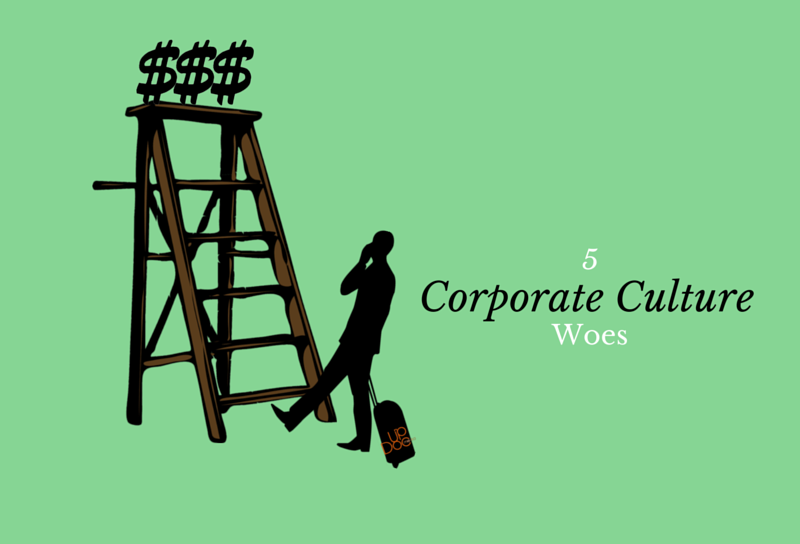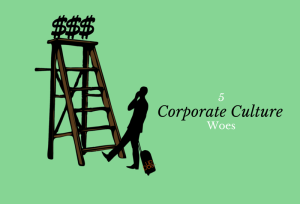

Over the last two weeks, I’ve been getting a lot of questions about corporate culture and organizational behaviors as it pertains to the career path, leadership, and change. As I was reflecting on the advice I gave, I started chuckling at what seemed to be a revolving theme of corporations and their cultural challenges. All together, I found that there are five consistent stumbling blocks to which businesses consistently find themselves being hindered by. Then, thinking further, I realized that these woes are paired with five elements of management excellence and five management behaviors which serve as signs for you to run like the plague. So! This week, we’ll be covering content on organizational culture, areas to avoid, and ways to strengthen your team.
Starting off our week: Here are…!
5 Corporate Culture Woes
1. The money.
This is perhaps one of the most common and one of the most destructive of corporate culture woes. Companies which are all about the money convey this so very clearly as all of their decisions ultimately are about the bottom line. However, these companies tend to be short sighted. It’s not about the bottom line next year, five years from now, or even ten years from now. They only care about what’s happening in the moment. Rash decisions are commonly made by companies who only care about the money with very little consideration or regard about the long term effects. These types of companies tend to over work their employees, pushing for productivity, micro-managing staffing and scheduling, and most of all, approving huge (and very unproductive) leadership meetings while denying purchase orders for basic office supplies.
2. The experience.
While this is typically a good thing, some companies focus too much on “the experience.” This could be the employee experience, the customer experience… whatever it is, the problem is that experiences tend to be subjective and rather hard to measure accurately. Companies that are over obsessed with a service experience or brand experience tend to sacrifice operational and financial efficiency to do so. Moreover, it is not uncommon for businesses with an imbalanced bias toward “the experience” to write off all sorts of businesses losses which are merely low hanging fruits in process optimization. In effect, by focusing on how everyone feels, such organizations sacrifice a healthy bottom line, causing a downward spiral where the finances can no longer support “the experience” itself. While a strong and favorable brand experience is absolutely essential to a business’ success, it must also be balanced out with sound financial strategies and efficient execution in their operations.
3. The hours.
Wanting “my hours” or being entitled to “my shift” are phrases to look out for as dead give-aways to this corporate culture woe. This woe is not far from “the money” and typically is held strongly by floor level operators who are fighting tooth and nail, stabbing front to back, and throwing their colleagues under any semblance of a bus that appears to be available. Basically, such companies where everyone is obsessed with making sure they get the work they deserve represent an atrociously managed supply chain. With no good management system in place, floor level employees feel that their work is undervalued, underpaid, and unstable. However, they also feel like they have no other choice. It is always a situation of feast or famine to which turnover is higher than the industry average, and, operational managers are stress out beyond belief. Typically, turnover for the average company in the US is 15% of employees per year. And, managers tend to last 3-5 years. Don’t be surprised to see 20-40% annual turnover within the first year that a new manager takes the helm.
4. The process.
Phrases such as “we’ve always done it this way” or “it is just the way things are done” or even “we have to follow policy and procedure” are road signs that the corporate culture is all about the process — forgetting about results. I find that older organizations who have tried a handful of times to rejuvenate their organizational culture suffer from this corporate woe. Typically, such companies like to promote from within, heavily bias employee loyalty, and even more so, bias favorably to the number of years employees have done their jobs rather than how well they do it. Typically, the human resource profile of such organizations are a dead even split between 10+ year veterans and <= 3 year new entrants. The problem with this woe is that the organization is betting on momentum and momentum alone. Years of past success a decade or even two decades ago are seen as a gold mine which is still producing value; when in fact, the truth is that in the next 18 months, things are about to get very ugly due to a poor human capital pool and long term aggregate effects of not delivering value to the marketplace.
5. The top.
You know the phrase, we’ve all heard it… “(The) *Proverbial fecal matter* rolls downhill.” Companies obsessed with a top heavy, entitled leadership expresses itself with floor level employees who basically view management as bullies if not monsters. Usually, managers eat lunch alone, lock themselves away in their office, and are rarely seen on the floor. They are not approachable, nor are they trusted. For the most part, the human resource department is viewed as management’s co-conspirator. No matter the complaint or grievance laid upon management, the little guy always loses. Companies who only value the top tend to pay their employees very well, either in benefits or in direct compensation. It’s kind of a financial message of “Here’s for putting up with the B.S.” — please don’t buck up and sue us, because you’ll probably win. When it comes to companies with this corporate woe, they tend to be very reactive to any complaint whether it is internal or external. There is a huge side-culture of blame game to which no one every seems to take responsibility. In fact, such companies are experts of passing the buck… even to their own customers.
There are some short term and long term solutions to corporate culture woes. Strategic change is a tricky thing; the fact is that historically, an overwhelming majority of companies fail in their change initiatives because of incumbency, inertia, and incompetence. It takes bold leadership with many months of seeding, planning, and savvy execution. Ultimately, it needs to be driven from the bottom up, curated from the top down, and validated by a third party. Such is the only way to rectify corporate culture woes.









